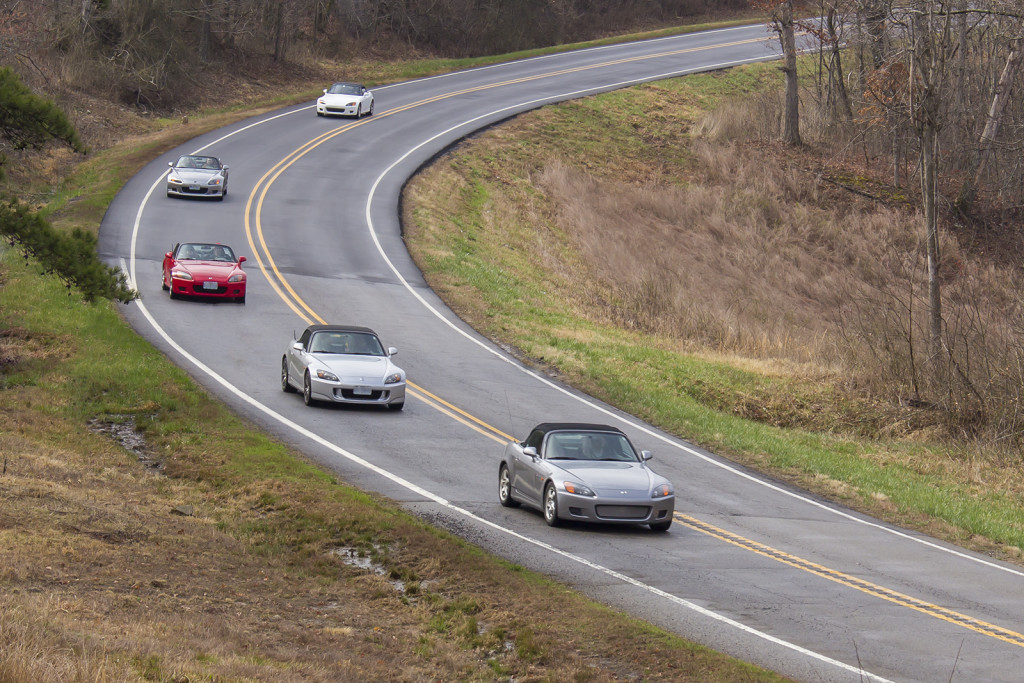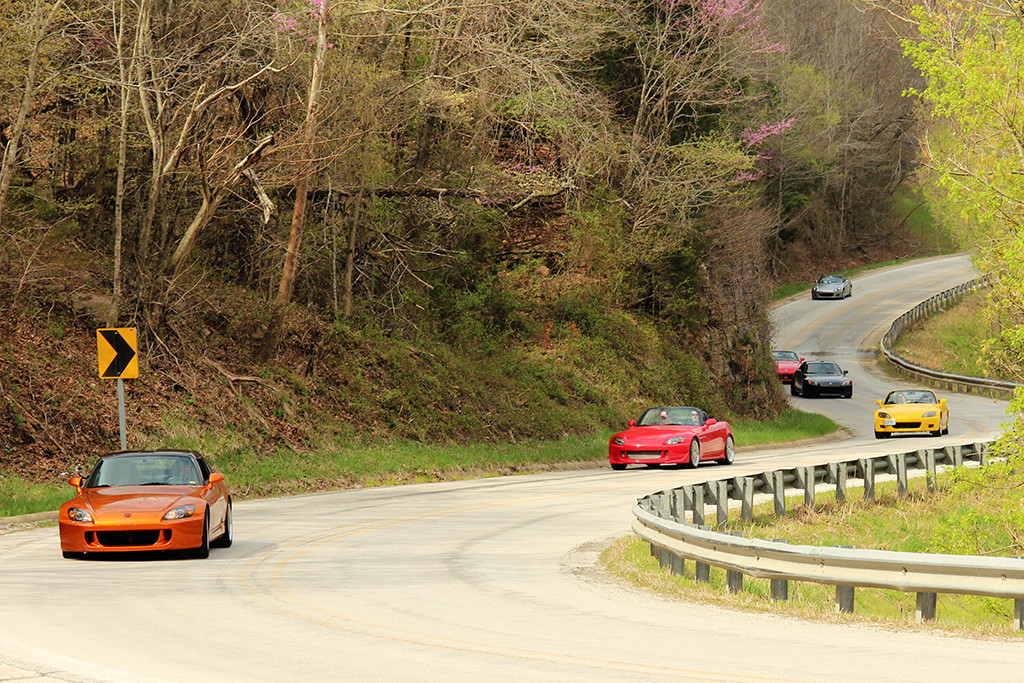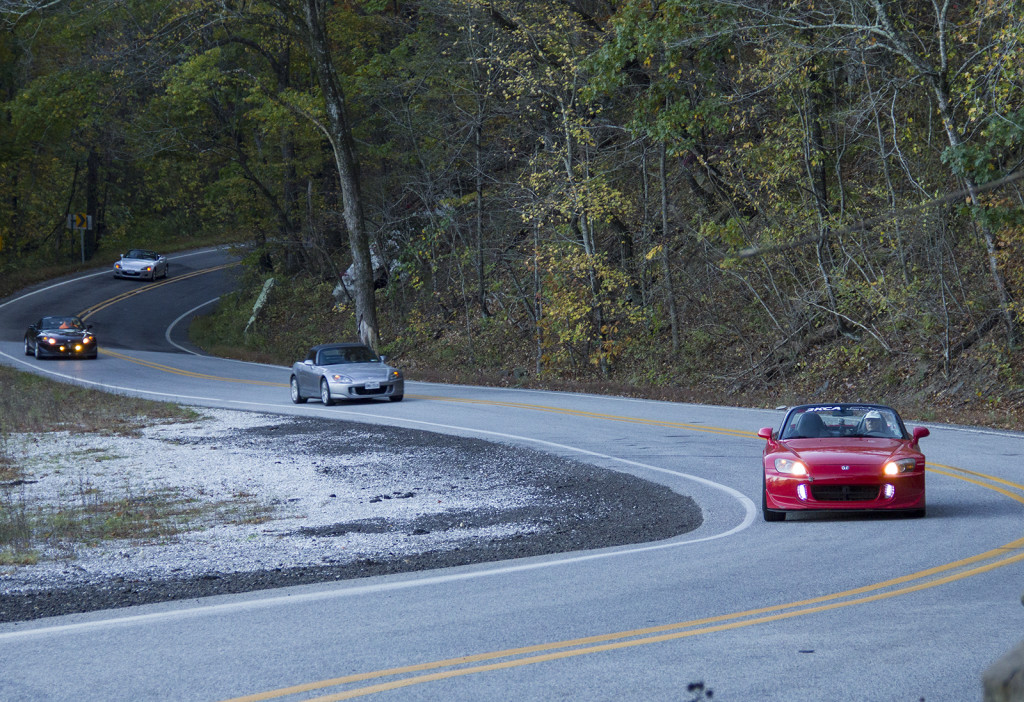So You Want to Lead a Group Drive?

You’ve had your car for a while, you feel you know pretty much what you’re doing, you think there isn’t much new you can learn… so, you’re going to get twenty or thirty of your closest friends together and organize and lead a drive.
Hold up there, Skippy. There are a few things you might want to do before you head out to the mountains or the seashore or the local fast food joint with those closest forum friends following you.
Before the drive:
-
Plan a route (duh!). You know all those neat roads you’ve been driving. Why not share them with a few good friends? Have you ever counted how many stoplights are on that road? How about cross streets? Potholes deep enough to swallow a car? It’s hard to find a route that doesn’t involve towns, stoplights, pedestrians and other bothersome impediments to open-road fun.
-
Drive your newly designed route a couple of times. Sure, you have driven that route a hundred times. Never seen another car, never seen a squirrel even. Now, think about having fifteen or twenty other cars behind you. Still feel comfortable? Welcome to the wonderful world of responsibility. It’s easy to drive by yourself, you do it almost every day, but now you have to make sure that a bunch of other people who may have never been on that road are going to feel as comfortable as you do. Nothing ruins a great day like somebody breaking something.
-
See any hazards? Just lots of pretty trees and mountains? Ever think about all those leaves and how slippery they are when they get wet? How about those rocks that seem to fall down hillsides at the most inopportune moment? How about that nice, nifty, new road construction that wasn’t there last week? If you can drive the route the day before your scheduled group drive, you can spot new problem areas that weren’t there before.
-
Create a map. Never done that? Try maps.google.com. Google is really good at helping you create detailed maps. You’ll have to do some work, like figure out where your starting point happens to be and what direction you plan on going to get to that finishing point, but that should be fairly easy now that you’ve driven the planned route a couple of times, right?
-
Pick a couple of good friends (preferably ones who you think would volunteer to follow you if you were leading). Give them the map and let one of them lead. How many times did you get lost? Sure, you know where you’re going but can anyone else figure that out? Planning is your friend and invariably, someone will get separated enough that they have no idea where they’re going. A good map is your friend.
-
Select a place to meet. Unless you happen to live somewhere that has a spare thirty or forty parking spaces that aren’t being used, check out local malls and shopping centers. You might want to ask the management of that mall or shopping center if they’d have any objection to you having thirty or forty close friends hang out in their parking lot for a couple of hours one Saturday or Sunday. If they say they’d rather be attacked by rabid dogs, you might want to look somewhere else. Keep looking until you find a place that has no objections. True, you want lots of people to come along on your drive but, that generally doesn’t mean the local LEOs and it’s really embarrassing to be run out of your chosen parking area.
-
Start a drive thread on all the local S2000 forums and invite people to come along once you’ve picked a date and time. Make sure you post a link to the drive map (see number four, above) so that people who are interested can see where you might be leading them. Surprisingly, not everyone wants to drive that half-a-lane wide, gravel, country road that you think is the ultimate in driving fun. You might also want to ask everyone to print out and sign a waiver so that they realize they’re responsible for their own actions. Initially, many people will say they want to come, ask what they can bring, what and where they are going to eat, what you’re going to do when you get to the end of the drive and all those other trifling things that people always bug you about. Why isn’t this information in the first message? Check the edit button at the bottom of your first message and add all those details. It makes it easier for people to decide whether they’d like to drive along.

So now, it’s the day of the drive:
-
Pick a reasonable time for everyone to meet. That sounds simple, right? So, how long is the drive? Is it going to be long enough that people are going to start complaining that they want to eat and they want to eat NOW? If at all possible, plan ahead for lunch. Find a place to stop with a parking lot large enough for your group, then call the restaurant and let them know roughly how many people are going to show up (cell phones and rest stops make this really easy). Most places will prepare a fixed menu for your group with a limited number of choices at a fixed price. Nobody has to argue over who is going to pay what, everyone pays the same, the restaurant is happy, you’re happy (nobody gritching about paying too much) and, best of all, nobody hungry. How about potty stops? You did find some not too sleazy place for a potty stop, didn’t you? If you meet early, somewhere around an hour or so, people are going to start getting uncomfortable. Time for a rest stop. Pick a time and place that you can stop around one to two hours into the drive. Your fellow drivers (and their passengers especially) will thank you for it.
-
So all thirty of your closest friends managed to crawl out of bed on Saturday morning and find their way to the meeting place. Now what? Well, the first thing you might want to do is have a driver’s safety meeting and tell them the rules. You know, like not being stupid and passing on solid lines and that everyone should obey speed limits, especially in small towns, and to not cross yellow lines, and not VTECing through small towns and perhaps they might keep the noise below nose-bleed level, not overdrive their limits, and it’s not a race, and if they’re not comfortable with the drive pace, there’s no shame in changing groups and going with a slower group.
-
Have a FRS radio? Why not? They’re cheap and you can let everyone know road conditions, where the problems are, that patch of gravel that’s across the road and the guy with the hammer who doesn’t seem to like bunches of cars driving through his yard. Pick a channel and let everyone know what channel it is. Next, tell everyone to turn their radios on and have a radio check. You talk and let everyone else listen. Did they hear you? Good! They really don’t need to talk unless there’s a problem so let them do a radio check. Did you hear one or two familiar voices coming through all the noise? Great!
-
It’s almost impossible to lead more than ten or twelve cars in a group. For one thing, local traffic guarantees that you will lose three or four cars in the first ten minutes. Break up large groups into two or three groups of ten to twelve cars. Now you have some control. Find someone who likes to be at the back of the group. Make sure that person has a radio. He/she does? Great, you just got yourself a tailgunner. This is the person who is going to tell you when the last car (which just happens to be his/hers) passes through that stoplight. This is the car that’s going to keep an eye on the slow guy in the middle and make sure that he doesn’t get so far back from the front that he gets everyone lost (the dreaded accordion or rubber band effect). The tailgunner is your best friend, so be extra nice to him/her. If he/she sees trouble coming from behind the group, he/she’s the person who’s going to notify you. Again, be really nice to him/her. Your tailgunner can save you money, time, and court appearances.
-
Try to put the groups together by skill levels or colors or something that they all have in common. Try not to put the newbies in a group of people who’ve had their car for eight years and spend weekends at track events. The purpose is to have people enjoy the drive, not endanger themselves and everyone else, and not spend the entire time having to worry about driving skill levels. People with similar experience should be together and lead by someone more experienced. That group leader watches to make sure nobody is driving over their skill level and slows down (or speeds up) as necessary to keep the group together. Leaving places where the pace has slowed, try not to rocket away. The last couple of people in the group might have been caught at a red light or stop sign. If you go blasting away, they’ll have to speed just to catch up with the group. Keep an eye on everyone and make sure you don’t hit supersonic speeds until your tailgunner tells you everyone is clear. Accordions are great musical instruments (well, maybe not) but not as drive groups. That accordion (or rubber band) spread makes it difficult to keep everyone together.
-
In your forum post, remind everyone to print out the drive map (they won’t, but you’ve told them). Give every drive leader a map! Let me repeat that, GIVE EVERY DRIVE LEADER A MAP (and bring some extras. The people who didn’t print it out just discovered they’d like to have one)! You’ll get split up, I can guarantee it. There will be some guy who just has to show you that his ’67 Buick is as fast and handles as well as your S2000. Don’t believe it. At the first convenient, safe place, pull over and let Fireball go. It’s not worth the hassle of trying to keep your group together and deal with a moron at the same time.
-
Okay, time to line up the groups. Put the more skilled drivers in the first group. True, you don’t always know who the more skilled drivers are, but someone who bought the car last week should not be in the first couple of groups. Try to fit people into the correct group for them. No matter how carefully you try, someone will be in the wrong group. There’s always a newbie who just knows that he should be in the first group because he’s scored 10,000,000 points in “Fast and Furious” driving that trick Ferrari. You want to discourage this person gently but persuasively (if necessary, you can lie). At the first rest stop, you can adjust accordingly. Your tailgunner should let you know if someone seems to be in the wrong group. Move that car to another group where the driver will be more comfortable. Before you hit the road, make sure you know how many cars are in your group, who your tailgunner is and that you have a drive map. (You do have a drive map, right?) Do one last radio check, count the cars in the group once again (that newbie is still trying to sneak into the middle of the group) make sure everyone has their headlights on and then head out. Have the groups leave individually with a time buffer between each group. Do you really want all that attention first thing in the morning? I thought not. Amazing how much attention large groups of cars attract, especially S2000s and you meet the nicest people in blue and white cars with flashy lights.

You are on the road. Now what?
Congratulations, you’re leading a group of S2000s on your first big event. Feels good, doesn’t it? You’re the group master, the head honcho, el gran jefe. Well, not really but it’s nice to think you are. You are now going to spend time counting the cars behind you because even though you have a tailgunner, you really don’t want to get split up into two groups. At the same time, you’re watching the road, having your honey in the passenger seat trying to tell you where the first turn is, trying to listen to eight people talk on the radio at the same time and, oh yeah, enjoy yourself. If this sounds like work, well yeah, it is. It also happens to be a lot of fun. When you look in the rearview mirror and see a line of S2000s behind you, all of those headlights on and shining brightly, your honey telling you how wonderful the drive is (and you and your amazing organizing skills are), you know this is what feeling great is all about.
– kgf3076 (Ken)
